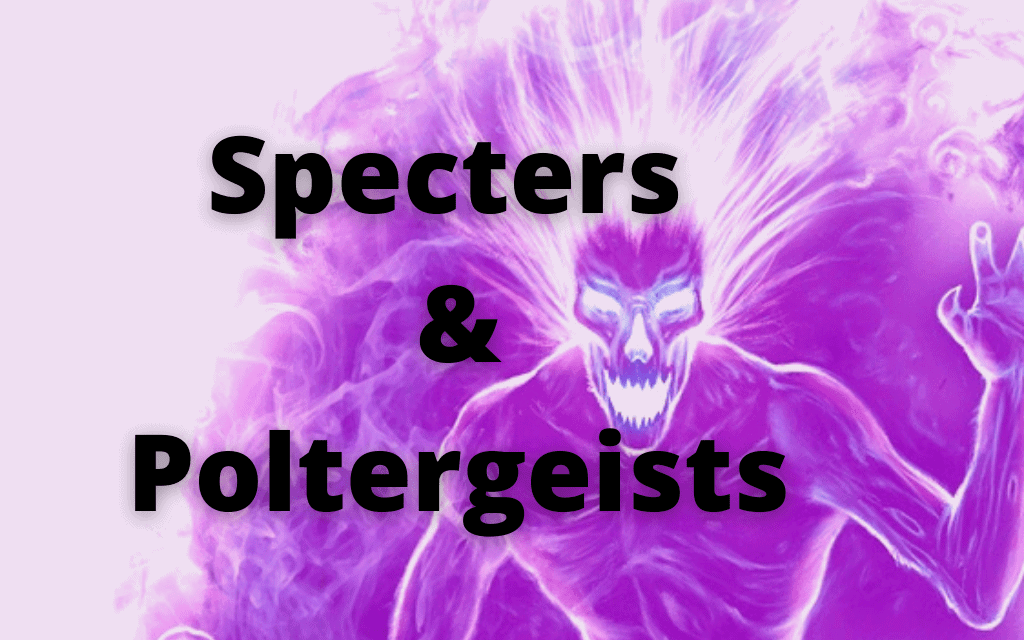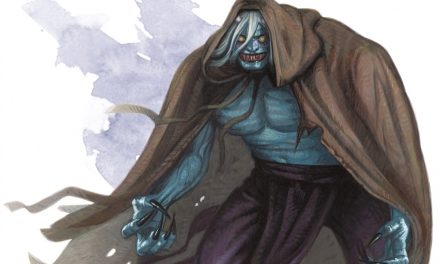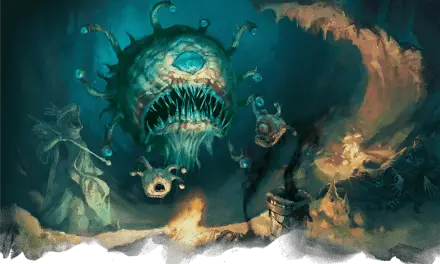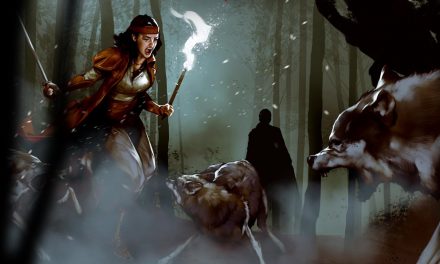In rotted, haunted houses or long-forgotten crypts, it’s wise to tread carefully. After all, not all who pass away are able to rest peacefully.
Those souls who remain may find themselves growing angrier with every passing day until they can’t take it anymore. In time, these spirits come to despise the living and lash out violently against others.
In other words, they become a specter.
Steel your nerves, dear adventurer. In today’s article, we brave undeath itself as we seek to learn more about these creatures.
This is all about the specter in D&D 5e. We’ll look at their lore, abilities, and give tips for DMs looking to run specters in their game as well as players who want to survive the encounter!
What is a Specter in D&D 5e?
Typically, death is the final end for mortals. Upon shedding their mortal coil, as it were, the mortal’s spirit passes into the afterlife.
Whether through fate, chance, or some other circumstance, the specter’s spirit has been denied this ability to pass on.
With no afterlife to pass to, the specter is cursed to roam the land of the living. Who or what they were in life no longer matters. In fact, they likely don’t even remember these details.
The spirit is first filled with sorrow. It longs for life or, at the very least, the ability to finally pass on. But that sorrow eventually (and often quickly) turns into an all-consuming hatred for the living.
While specters might be created by circumstance, dark magics are often responsible for the creation of these undead beings. They can be created by wraiths, necromancers, or even Hexblade Warlocks.
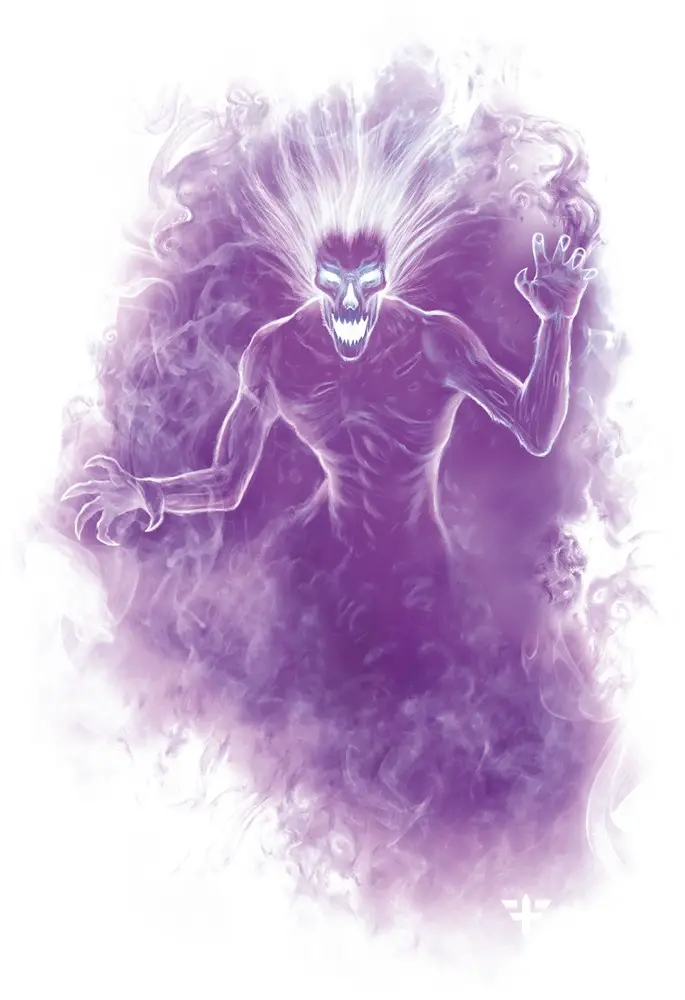
Specter Abilities
With a low Armor Class and so-so hit points, it might be easy to think of specters as being “all bark, no bite.”
But you would be very wrong!
First things first, specters are resistant to acid, cold, fire, lightning, and thunder damage. Furthermore, they’re resistant to bludgeoning, piercing, and slashing damage from nonmagical attacks.
Don’t even think about necrotic or poison damage. They’re completely immune to that.
Furthermore, they’re immune to most conditions. Specifically: charmed, exhaustion, grappled, paralyzed, petrified, poisoned, prone, restrained, and unconscious.
You’ll have a hard time getting away from a specter once it sets its sight on you. Not only do they have a flying speed of 50ft, but their incorporeal movement means they can pass right through objects and walls.
Specters attack with their Life Drain feature. On a hit, this deals 3d6 necrotic damage and the target has to make a DC 10 Constitution saving throw. If they fail, their maximum hit points are reduced by the amount of damage taken until they finish a long rest.
Continuing the adventure with lowered maximum hit points is certainly far from ideal. But if the specter reduces your maximum hit points to zero with its Life Drain, it is much worse! With a maximum hit point total of zero, you don’t get to make any death saving throws and your character is dead.
Yeah… they’re pretty scary!
So don’t underestimate the Specter’s low challenge rating! They are fully capable of instantly and permanently killing characters!
Related: 12 Monsters That Will Instantly Kill Characters
No Redemption
A specter’s torment can only end when its soul is destroyed.
Where a ghost might be able to be reasoned with (they seek to complete unfinished business so that they can pass), you’ll find no such pleasantries with a specter. If you are not able to defeat it and end its suffering, you will be just another one of its victims.
Specters are particularly drawn to forgotten, lonely places. There they lurk in sorrow as time goes on without them.
Months, years, even centuries can go by before the specter’s tormented soul is finally destroyed by some brave adventurers.
Still, specters attack their victims relentlessly. By the time one has been destroyed, how many of its victims’ remains litter the floor of the specter’s home?
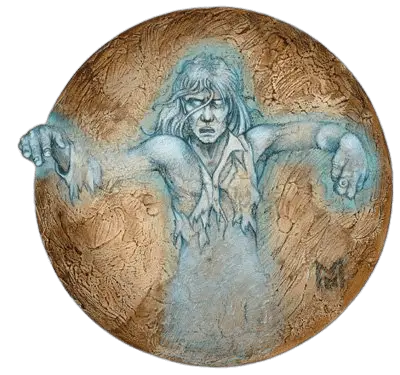
Fueled By Hatred
Like we mentioned at the beginning of this article, it’s not a big jump from “sorrow” to “hatred.”
These emotions are primal, powerful, and all that the specter has left. Even the slightest reminder of life is enough to send the specter into an absolute rage.
Full of sorrow and envy, specters have a pure hatred for the living. It reminds them of everything that they can never have for themselves.
The only way to calm itself down is for the specter to do whatever it takes to snuff out that reminder like a candle.
Unfortunately, you just might be that reminder…
This hatred of all things living is why specters avoid areas with sunlight. It represents a source of life and no specter is exactly capable of destroying the sun. (Hooray for small blessings, right?)
Because they hate sunlight, specters are most active at night or in places that sunlight can’t reach like deep underground crypts or long-forgotten dungeons.
Keep in mind that specters are attacking living creatures in a kind of emotional rage. They act quickly and show no mercy, but they also aren’t interested in cruelty or negotiation.
Specters in D&D 5e are not able to speak but they do understand any languages they knew in life. It’s not impossible to parley with a specter, but such a feat would be very difficult.
A character like an Undead Warlock or who is playing a Dhampir or Reborn from Ravenloft might blur the line between life and death enough to avoid a specter’s wrath. But even that will take some extraordinary effort if they really, really want to try and chat with such a being.
Like Mind Games? Meet the Nothic!
Specter Variant: Poltergeist
Within the Monster Manual, there is a variant block next to the specter for a poltergeist.
In some ways it’s a buffed specter, but it’s actually much more than that. As similar as these two entities are, there are some key differences that are worth mentioning.
Where specters are characterized mostly by a sorrowful rage, poltergeists are more characterized by their confusion. These are the lingering spirits of individuals who do not know how they died and have not been able to pass into the afterlife.
Acting out in this confusion, the poltergeist has a tendency to throw objects and even people.
Seeming to manifest some kind of telekinetic power, the poltergeist can pick up and launch objects weighing up to 150 pounds. These thrown objects deal 2d4 damage if they hit.
Creatures of medium or smaller size can also be thrown around like ragdolls by a poltergeist.
The poltergeist makes a Charisma check contested by the character’s Strength check. If the poltergeist wins, the character can be throw up to 30 feet away in any direction (including upwards.) If a character comes into contact with a hard surface or object, they take 1d6 damage for every 10 feet that they were moved.
A poltergeist might use this to throw a character out of a top floor window or down a flight of stairs for extra damage.
If all else fails, it has a telekinetic slam that deals 3d6 force damage.
Oh, and did I mention that the poltergeist is invisible? Yeah… That makes it an entirely different problem, doesn’t it?
Encountering a Specter
Everything about the specter is terrifying. As a CR 1 creature, it’s very likely that an encounter with a specter will be the first time in a campaign that a player has to start making a new character.
So, let’s now take a look at specters in combat. We’ll go over tips and tactics for Dungeon Masters to make the encounter truly terrifying then look at ways players can make sure that their characters survive!
Also Read: 10 Terrifying Monsters For Your Next Halloween D&D Game
Running Specters for Dungeon Masters
The specter’s greatest strength is its mobility. 50 feet of flying movement plus the ability to pass through walls and objects is pretty intense.
The specter can close in on the party very quickly. Emerging through a wall or the floor to take its victim by surprise, the specter is very scrappy. Despite having so-so hit points, its resistances make it considerably tougher against a party that doesn’t have magic weapons.
Keep in mind that specters are relentless in their attacks. A specter zeroes in on its target and will not stop harassing them until another party member gets its attention by dealing notable damage (6 or so, especially if its radiant), its victim dies, or it’s exposed to sunlight or Turn Undead.
Specters aren’t particularly tactical, but that doesn’t mean that they aren’t going to leverage their strengths in combat. Using the environment is hugely impactful in making an encounter with a specter memorable.
Having a specter swoop in, life drain a target, then move back beyond a wall is sure to both terrify and infuriate the party. The specter is tough enough to handle an attack of opportunity as it keeps up this hit-and-run assault.
Poltergeists also benefit from using the environment to their advantage. Throwing a party member out of a window, for example, deals extra damage but also forces the PC to quickly navigate back to where the fight is happening if they want to save their friends.
If a specter or poltergeist is affected by Turn Undead, they will quickly resume their assault once the effect passes.
In combat, you want the specter or poltergeist to be relentless. Remember: they’re motivated by their hatred for the living.
Fighting Specters as a Player
When you find yourself fighting a specter, it can be very easy to be overly reactive. This is especially true if you’re the one that it’s decided to focus on!
But don’t lose hope, dear adventurer. Let’s take this one step at a time!
Specters have two key weaknesses: their low armor class and their sunlight sensitivity.
If you have a way of letting sunlight into the space you’re fighting the specter, you can create some safer spots to defend yourself. For example, if you’re in a haunted house and it’s daytime, you might be able to smash open the window shutters and let some sunlight in.
Otherwise, let’s hope you have the Daylight spell ready (if you’re able to cast level 3 spells) or have an item like a Driftglobe handy!
The specter’s resistances are overcome by damage from magical weapons. Additionally, it doesn’t have resistance against damage like radiant or psychic. Spells like Guiding Bolt, Sacred Flame, and Vicious Mockery are early-level options that you’ll get a lot of use out of in an encounter with a specter.
If the specter is relying on hit-and-run type tactics like I described above, your best bet is to group up and take advantage of the ready action. When it swoops back in, your party will be able to deliver some swift punishment before it’s able to connect with its Life Drain.
Poltergeists are trickier since they are invisible. Look for ways to help your party overcome the disadvantage for attacking an invisible creature. Guiding Bolt is great for that as well (in addition to dealing very respectable radiant damage) but Faerie Fire is also a strong choice.
Whether you’ve got a specter or a poltergeist on your hands, they aren’t going to back down. Think fast, hit hard, and whatever you do… try not to scream…
Conclusion – Specters in D&D 5e
With so many wonderful and terrifying undead monsters in D&D 5e, it’s impressive how much the humble CR 1 specter stands out.
Leeching away a character’s maximum hit points is a cruel way to inflict damage. Even if the character survives the encounter, they’re going through the rest of the adventuring day with potentially WAY less hit points.
Have you had a memorable encounter with a specter in your D&D games? Got a request for the next featured monster? Let’s chat in the comments!
Want to be the first to know about all of the latest DM tips, player guides, book reviews, and more for D&D 5e? Sign up for the Tabletop Joab newsletter with the form below!

